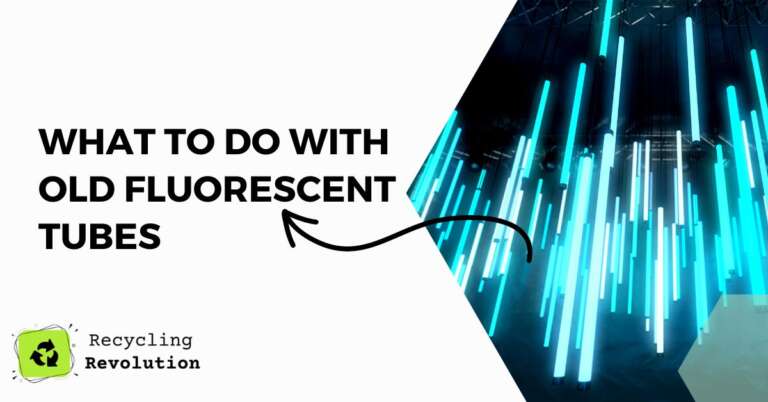Fluorescent tubes have been a mainstay in many homes and businesses for decades. They’re known for their energy efficiency and longevity.
However, as with all things, they eventually come to the end of their life cycle. But here lies the issue: what do you do with them once they’ve burned out?
tl;dr: Proper disposal of old fluorescent tubes is crucial due to the hazardous materials they contain. It’s recommended to recycle them at local recycling centers or hazardous waste collection sites. Avoid dumping them in your regular trash bin.
Why Proper Disposal Is a Must
Fluorescent tubes aren’t just any regular light bulbs. They contain a small amount of mercury, a heavy metal that poses serious environmental and health risks.
- Environmental Concerns: Mercury can seep into the ground and contaminate local water supplies. Once it enters the food chain, it can accumulate in fish and other marine life, leading to health risks for those who consume them.
- Health Concerns: If inhaled or ingested, mercury can cause a range of health issues from irritability, tremors, to memory problems and even kidney damage.
Note: Some studies, such as those by the Environmental Protection Agency (EPA), have highlighted the adverse impacts of mercury on our environment and health, underscoring the importance of proper disposal.
Recycling: The Best Way Forward
1. Find Local Recycling Centers: The safest way to dispose of fluorescent tubes is to recycle them. Many recycling centers accept them. However, I recommend checking in advance whether your local facility handles fluorescent tubes.
2. Retailer Take-Back Programs: Some retailers and manufacturers offer take-back programs where you can return old tubes for recycling. This is not just eco-friendly but also convenient.
3. Mail-back services: For those who don’t have a recycling center nearby, some companies provide mail-back services. You can send your old tubes in provided containers, and they’ll take care of the rest.
Hazardous Waste Collection Events
Many municipalities hold hazardous waste collection events where residents can drop off a variety of unwanted items, including fluorescent tubes. These events are a great way to ensure your tubes are disposed of responsibly.
I recommend marking your calendar for these events and setting aside your old tubes until then.
Safe Storage Until Disposal
Should you find yourself in a position where you can’t immediately dispose of your old tubes, it’s essential to store them safely.
- Keep them in their original carton: This will protect them from breaking.
- Store in a cool, dry place: Away from children and pets.
- Avoid placing them where they might get crushed or broken: Broken tubes can release the mercury they contain, posing a risk.
What NOT To Do
- Don’t dump them in your regular trash: Even if it’s allowed in your municipality, I recommend against it. The risk of environmental contamination is too high.
- Don’t break them: This releases mercury into the environment. If a tube breaks, ensure you clean it up safely, wearing gloves and ensuring proper ventilation.
Are LED tubes a safer alternative?
Absolutely. LED tubes do not contain mercury and are also more energy-efficient. If you’re considering a switch, it’s a great option.
Understanding the Composition of Fluorescent Tubes
It’s beneficial to understand what exactly makes up these tubes. Fluorescent tubes are more than just glass. They’re a concoction of a few materials: the phosphor coating that gives off light, a small amount of argon gas, and the notorious mercury vapor.
The last component, mercury, while crucial for the functioning of the tube, is where the environmental concern lies.
The Environmental Impact of Mercury
Mercury is termed as a persistent bioaccumulative toxin. This means that once it’s released into the environment, it doesn’t just go away. Instead, it sticks around, accumulating in organisms and moving up the food chain.
Studies from institutions like the World Health Organization (WHO) indicate that aquatic ecosystems are particularly vulnerable. Mercury transforms into its toxic form, methylmercury, in water.
This methylmercury is then taken up by small aquatic organisms, which are consumed by larger ones, concentrating the toxin at every level of the food chain. This is why predatory fish at the top of the food chain often have high mercury levels, posing risks to humans and wildlife that consume them.
Preventing Accidental Breakage
Handling old tubes with care is not just about safe disposal; it’s also about ensuring they don’t break in the first place.
Safe Handling Tips:
- Wear gloves: This will protect your hands from sharp edges and any mercury exposure in case of accidental breakage.
- Avoid holding by the ends: The ends of the tubes are the weakest points. Holding from the middle distributes the pressure evenly.
- Transport in original packaging: If possible, I recommend keeping the original packaging of the tubes for safe transportation when it’s time for disposal.
DIY Repurposing Ideas: Turning Old Tubes into Art
One engaging, albeit less common approach, is repurposing old tubes. If you’re the artsy type, there’s potential to turn these tubes into decorative items. However, I recommend this only for tubes that are still intact and not nearing the end of their lifecycle (as older tubes might have higher risks of breaking).
Some ideas:
- Garden borders: Lay them side by side to create an interesting, luminescent border for your garden beds.
- Lamps: With some electrical know-how, they can be refashioned into unique lamps.
- Wall art: Arranging tubes artistically on a board or canvas can result in an impressive piece of wall decor.
Note: Always ensure that any repurposing does not compromise the tube’s integrity, leading to breakage.
Fluorescent Tube Recycling Process
Wondering what happens after you’ve handed over those old tubes to the recycling center? Here’s a peek into the process:
- Crushing: Tubes are crushed into small pieces in machines designed to contain and collect the mercury vapors.
- Separation: The crushed material is then separated into various components. This usually involves sieving and air separation.
- Mercury Distillation: The collected mercury is distilled and can be reused in new fluorescent tubes or other products.
- Reprocessing: The other materials, like aluminum and glass, can be reprocessed and used in various products.
Understanding this process can be reassuring for many. Knowing that your old tubes are not just dumped somewhere, but their components are meticulously separated and reused, makes the effort of proper disposal all the more worthwhile.
The Shift to Safer Alternatives
While fluorescent tubes have served us well over the years, the global shift is now leaning towards even more energy-efficient and environmentally friendly options, like LED lighting. LEDs are not only mercury-free, but they also consume less power, have longer lifespans, and provide a range of lighting options in terms of color and intensity.
I recommend considering LEDs for your next lighting upgrade. Not only will you be reducing your carbon footprint, but you’ll also be saving on electricity bills in the long run.
Conclusion
Proper disposal of fluorescent tubes isn’t just about being eco-friendly; it’s about protecting our planet and our health. By recycling them, participating in take-back programs, or attending hazardous waste collection events, you ensure that the harmful mercury they contain doesn’t end up harming our environment. Remember, every small step counts.
So, the next time one of those tubes burns out, take a moment to dispose of it responsibly.
FAQs
Can I throw my old tubes in the regular trash bin?
While some municipalities might allow this, it’s strongly advised against due to the environmental risks.
What should I do if I accidentally break a tube?
Ensure proper ventilation in the room, wear gloves, and carefully clean up the debris. Avoid using a vacuum as it can spread the mercury vapor.

